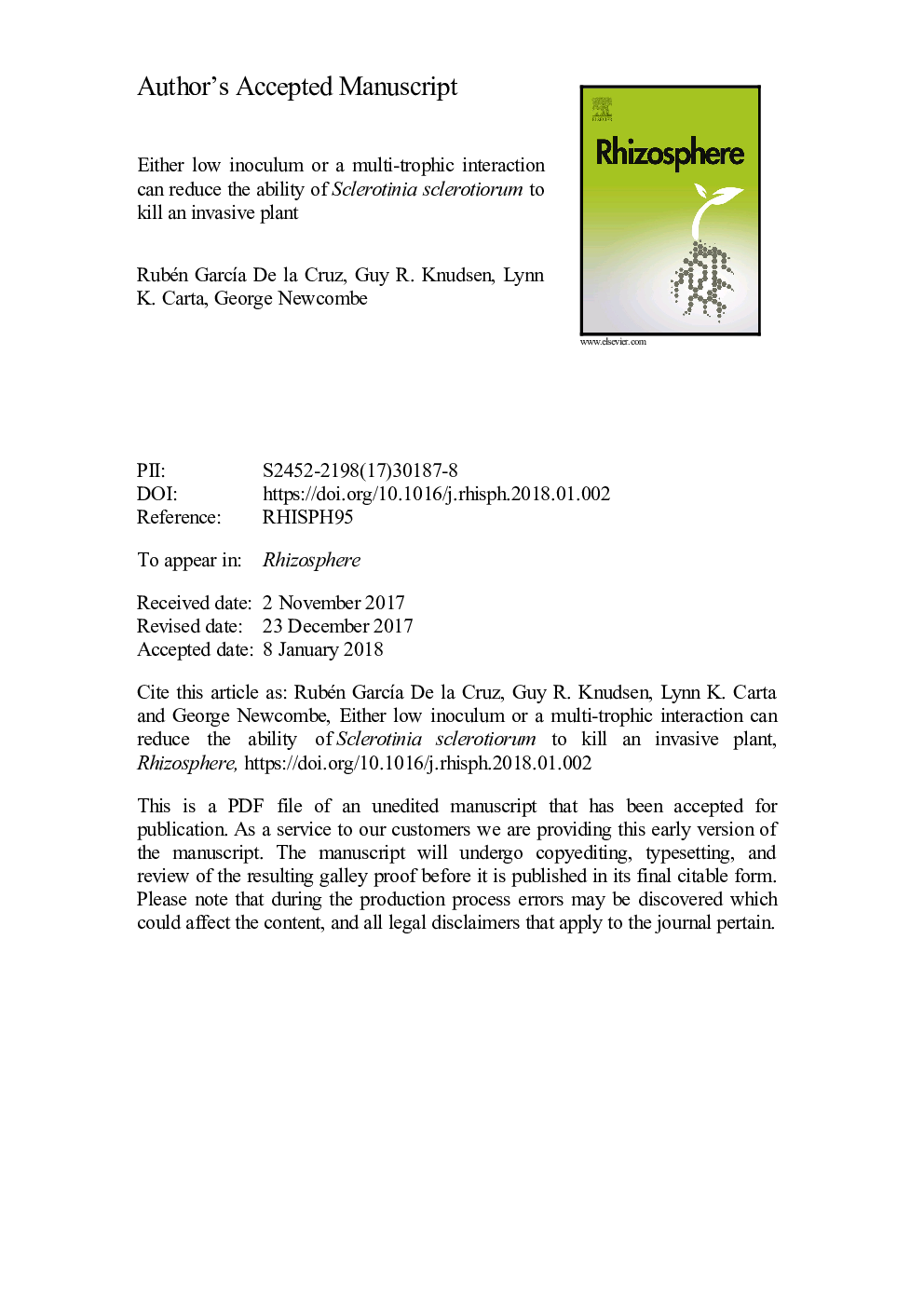| کد مقاله | کد نشریه | سال انتشار | مقاله انگلیسی | نسخه تمام متن |
|---|---|---|---|---|
| 8882194 | 1625039 | 2018 | 19 صفحه PDF | دانلود رایگان |
عنوان انگلیسی مقاله ISI
Either low inoculum or a multi-trophic interaction can reduce the ability of Sclerotinia sclerotiorum to kill an invasive plant
دانلود مقاله + سفارش ترجمه
دانلود مقاله ISI انگلیسی
رایگان برای ایرانیان
کلمات کلیدی
موضوعات مرتبط
علوم زیستی و بیوفناوری
علوم کشاورزی و بیولوژیک
علوم زراعت و اصلاح نباتات
پیش نمایش صفحه اول مقاله

چکیده انگلیسی
In greenhouse experiments Sclerotinia sclerotiorum has killed seedlings of Centaurea stoebe, an invasive plant that is commonly known as spotted knapweed in Pacific Northwestern North America. Sclerotinia sclerotiorum is widespread in this invaded range, yet mortality of the plant due to S. sclerotiorum has not been observed in the field. Our greenhouse experiments address this paradox. To explore multitrophic interactions, four levels of inoculum were used: zero (control), and 1, 5, or 10 alginate pellets. Combinations of four organisms were varied: two fungi (phytopathogenic Sclerotinia sclerotiorum and mycoparasitic Trichoderma harzianum), one fungivorous nematode (Aphelenchoides saprophilus), and the host plant (Centaurea stoebe). Soil of potted knapweed was inoculated with T. harzianum (10 pellets per 200Â g of soil) either (i) one week before adding either the nematodes or S. sclerotiorum, or both, or neither, or (ii) the same day when the nematodes and/or S. sclerotiorum were added, or (iii) left untreated with T. harzianum. The first, and overarching result, was confirmation that either 5 or 10 pellets of Sclerotinia sclerotiorum killed all seedlings 15 days post-application. In contrast, no mortality of seedlings was seen in the control but there was also no mortality with low inoculum (i.e., 1 pellet). Secondly, of 12 whole/subplot treatment combinations in total, six included phytopathogenic S. sclerotiorum, and of these six, the plants were killed in five. However, in one treatment combination (i.e., the addition of Aphelenchoides saprophilus nematodes, 2000 per 200Â g of soil, one week after inoculation with T. harzianum) plant mortality due to S. sclerotiorum was suppressed. These findings suggest that both low inoculum dose and specific, multi-trophic microbial interactions may contribute to the absence of Sclerotinia disease of knapweed in its invaded range in the Pacific Northwest.
ناشر
Database: Elsevier - ScienceDirect (ساینس دایرکت)
Journal: Rhizosphere - Volume 5, March 2018, Pages 76-80
Journal: Rhizosphere - Volume 5, March 2018, Pages 76-80
نویسندگان
Rubén GarcÃa De la Cruz, Guy R. Knudsen, Lynn K. Carta, George Newcombe,